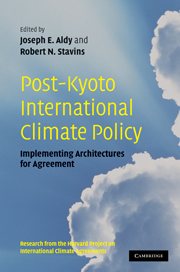Book contents
- Frontmatter
- Contents
- Harvard Environmental Economics Program, International Advisory Board
- Harvard Project on International Climate Agreements, Faculty Steering Committee
- Harvard Project on International Climate Agreements, Project Management
- List of figures
- List of tables
- List of contributors
- Foreword
- 1 Introduction
- Part I Alternative international policy architectures
- Part II Negotiation, assessment, and compliance
- Part III The role and means of technology transfer
- Part IV Global climate policy and international trade
- Part V Economic development, adaptation, and deforestation
- 18 Reconciling human development and climate protection: a multistage hybrid climate policy architecture
- 19 What do we expect from an international climate agreement? A perspective from a low-income country
- 20 Climate accession deals: new strategies for taming growth of greenhouse gases in developing countries
- 21 Policies for developing country engagement
- 22 International forest carbon sequestration in a post-Kyoto agreement
- Part VI Modeling impacts of alternative allocations of responsibility
- Part VII Synthesis and conclusion
- Appendix A Selected List of Individuals Consulted, Harvard Project on International Climate Agreements
- Appendix B Workshops and Conferences, Harvard Project on International Climate Agreements
- Glossary and Abbreviations
- Index
18 - Reconciling human development and climate protection: a multistage hybrid climate policy architecture
Published online by Cambridge University Press: 05 June 2012
- Frontmatter
- Contents
- Harvard Environmental Economics Program, International Advisory Board
- Harvard Project on International Climate Agreements, Faculty Steering Committee
- Harvard Project on International Climate Agreements, Project Management
- List of figures
- List of tables
- List of contributors
- Foreword
- 1 Introduction
- Part I Alternative international policy architectures
- Part II Negotiation, assessment, and compliance
- Part III The role and means of technology transfer
- Part IV Global climate policy and international trade
- Part V Economic development, adaptation, and deforestation
- 18 Reconciling human development and climate protection: a multistage hybrid climate policy architecture
- 19 What do we expect from an international climate agreement? A perspective from a low-income country
- 20 Climate accession deals: new strategies for taming growth of greenhouse gases in developing countries
- 21 Policies for developing country engagement
- 22 International forest carbon sequestration in a post-Kyoto agreement
- Part VI Modeling impacts of alternative allocations of responsibility
- Part VII Synthesis and conclusion
- Appendix A Selected List of Individuals Consulted, Harvard Project on International Climate Agreements
- Appendix B Workshops and Conferences, Harvard Project on International Climate Agreements
- Glossary and Abbreviations
- Index
Summary
Introduction
Human activity is causing irreversible harm to the climate system and the global environment. According to the Intergovernmental Panel on Climate Change (IPCC 2007), the earth's average surface temperature has increased by 0.7 degrees Celsius (°C) in the last century. Observable indicators of this change include rising sea level, declining snow cover, glacier melt, and so forth. Avoiding a future catastrophic climate crisis will require the global community to establish a valid and effective global climate policy architecture. Global emissions will have to be brought rapidly under control to stabilize atmospheric greenhouse gas (GHG) concentrations at roughly 450 parts per million (ppm) carbon dioxide (CO2) equivalent—the stabilization target thought to be necessary to prevent global mean temperatures from exceeding the widely endorsed 2°C threshold (Scientific Expert Group 2007; Stern 2006). To achieve this target, any international climate regime ought to balance considerations of efficiency and equity—that is, it ought to solve the emission reductions, economic growth, and humanitarian problems of climate change at the same time.
As the first step in the international community's battle with climate change, the Kyoto Protocol—after endless negotiations over the last two decades—has failed to deliver aggressive emission reductions; on the contrary, global emissions are still rising. Given the lessons from past Kyoto negotiations, we can lay out the key challenges for a new post-Kyoto climate regime.
- Type
- Chapter
- Information
- Post-Kyoto International Climate PolicyImplementing Architectures for Agreement, pp. 563 - 598Publisher: Cambridge University PressPrint publication year: 2009
- 2
- Cited by



